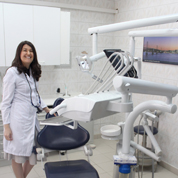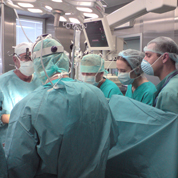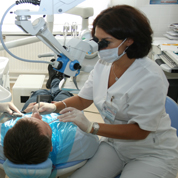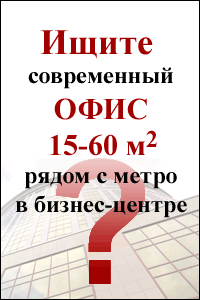The Russian private medical services industry today

Two important events that could radically transform the Russian private, pay-per-use, medical services industry took place at the beginning 2013. Specifically, on Jan. 1, 2013, all private clinics in Russia can provide free primary healthcare under the General Medical Care Insurance Policy Law (more popularly known by its Russian acronym as OMS). Under this policy, treatment is not financed by patients themselves, but via a special State Social Welfare Fund. Private clinics willing to make use of this opportunity must make this known to the authorities on/or before Sept. 1, 2013.
The second event that would further drive the growth of the industry was the adoption of a federal law allowing public healthcare facilities to officially and legally accept payments for certain services. In other words, state hospitals/clinics can now officially demand that patients pay for "medical services that are not covered by the basic standards of medical care under the OMS law."
These changes, according to officials and regulators of the private healthcare sector, should help remove most of medical services from “the shadow” unto a more civilized economic platform.
It is important to note that the prices for medical services in both public and private medical institutions are set by their shareholders. However, the latter must provide full information on the types and scopes of medical care that patient are supposed to get for free under the OMS and which they need to pay for.
This law opens up new opportunities for the expansion of real and more effective competition among private clinics, State Duma legislator Oksana Dmitrieva noted. “Citizens have yet to know that they can now go to any medical center, including private clinics included in the mandatory health insurance system, for free treatment."
However, there are opponents of the policy, who have seen such novelty leading to “legal commercialization” of the public healthcare. This is because paid-for services will now officially become one of the main sources of revenues for state healthcare facilities and, therefore, deprive citizens of their constitutional right to free medical care under the OMS law, Alexander Saversky, the head of the Patients Protection League, explained. “Medical practitioners are not only given the right to treat people for money, but also the right to force patients to do so, thus creating financial problems for them."
Beside these regulatory changes, another important factor driving growth in the private healthcare sector, according to experts, is the poor quality of services in the so-called “free medicine” in the public sector. According to experts, despite the fact that patients have to pay for such treatment, and even in some cases, the prices are much higher than those demanded in private clinics.
The good news, according to experts, is that as long as there is no substantial improvement in the quality of "free medicine” in the public healthcare sector, the private segment will continue to grow at a fast pace. This growth stems from the citizens’ outright negative attitude to the low quality of free medicine, according to Step-by-Step Group, a market research agency.
Private clinics can compete with state-owned hospitals not only because of the latter’s numerous shortcomings, but because they over the years have learned to provide high-quality care at a high level of service, according to Alla Anastos, the chief doctor of US Dental Care. “Private medical centers have better management, more mobility, are quicker to adopt and master new technologies,” she explained. “Also, they create a variety of service programs for the convenience of their patients, and most importantly, they relate to patients in a different way. In other words, private clinics right from incorporation are focused to meet the needs of patients."
 Alla Anastos, the clinical director at US Dental Care: "The state of the modern medical services market fairly well reflects the dynamics of the overall development of the private services sector in Russia. In the 1990s, we observed chaotic development of the private healthcare, but the last 10 years have really been positive for the industry."
Alla Anastos, the clinical director at US Dental Care: "The state of the modern medical services market fairly well reflects the dynamics of the overall development of the private services sector in Russia. In the 1990s, we observed chaotic development of the private healthcare, but the last 10 years have really been positive for the industry."
Poor or inadequate funding, according to experts, is the main problem of the public healthcare system that undermines its capability to adequately compete with its private peers. "Only about 3.9% of national GDP is spent on our healthcare system, compared to at least 6% of GDP in other developed countries, Leonid Roshal, the president of the National Medical Chamber of Russia and director of the Moscow Institute of Emergency Pediatric Surgery & Traumatology at the Russian Academy of Medical Sciences, noted. “Any national healthcare operating below [the 6% of GDP] level is assumed to be in a state of collapse. It is no wonder that Russia, according to the level of development of public healthcare, is currently ranked 120th in the world."
All these factors help explain the rapidly growing number of clients seeking private healthcare services, a trend expected to further boost growth of healthcare patients. Thus, according to most experts’ forecasts, the number of private will reach 87-90mln by 2016 and up to 100mln by 2020.
The share of private medicine in total market size
The size of the Russian medical services market in 2012, according to the analytical agency, BusinesStat, exceeded RUB1.1trln. According to the agency’s forecasts, this amount is expected to increase in the next five years and exceed RUB1.8trln by 2017. The legal private medical sector will more than double from the current level of RUB207bln to at least RUB 432bln.
According to BusinesStat, the lion’s share of revenue, almost RUB690bln, was generated via the OMS programs in 2012. The so-called “classical commercial medicine,” a term for treatment paid for by patients themselves, generated about RUB207.1bln, while an additional sum of RUB109bln came from the Obligatory Medical Care Insurance (or DMS) programs. In other words, the OMS and DMS programs, according to the Step-by-Step Group, accounted for about 62% of the total revenues generated by the industry in 2012. The remaining 38% of the revenues were paid for by patients themselves.
Today, private clinics represent just about 5% of all the functioning health facilities in Russia, excluding dental clinics, according to research company Cegedim Strategic Data. According to experts, the number of health facilities in major cities will gradually decline against the background of fast-rising number of "customers" by 2020. This stems from a convergence of different market and economic factors. These include the ongoing consolidation of the market, enlargement clinics, the increasing trend of globalization of medical services, exits of less efficient players, including the so-called “flight-by-night” clinics.
These processes are being driven by the desire of patients to receive comprehensive medical services in a single institution. But in any case, the market will increase in value, fueled by growth in large cities with populations are less than one million residents.
On the Russian private medical services market there are virtually no major players and significant brands, as the market shares of even the largest sector players do reach one percent, Yevgenia Parmukhina, CEO of Research.Techart, a Moscow-based research firm, said (see Expert opinion: Research.Techart). Most private clinics tend to specialize in very narrow market niches, such as dentistry, urology, gynecology, laboratory diagnostics, etc. In addition, most private clinics, as a rule, operate only in some regions, she added. “The sector has very few private clinics with a complete multi-cycle treatment and diagnostic services, as in the developed countries, where such players form the backbone of the private,” healthcare market, she said. “The main reason for this is the competition with public health facilities which in fact also provide pay-for services."
 Lev Averbach, the CEO and chief medical officer of Coris Assistance in St. Petersburg: "The Russian private medical services market, in our opinion, is mostly developing only in big Russian cities, where they are also mostly densely concentrated in the country. The private medical segment is led by dentistry, whose services are most needed by patients. Other medical services account for about 10-15% of the market, and most of these services are offered by gynecology, urology and cosmetology".
Lev Averbach, the CEO and chief medical officer of Coris Assistance in St. Petersburg: "The Russian private medical services market, in our opinion, is mostly developing only in big Russian cities, where they are also mostly densely concentrated in the country. The private medical segment is led by dentistry, whose services are most needed by patients. Other medical services account for about 10-15% of the market, and most of these services are offered by gynecology, urology and cosmetology".
The predominance of highly specialized clinics players stems from the so-called high level of investment entrance threshold to the market. The main component of this so-called "entrance ticket", according to industry players, is the cost of medical instruments, which are among the most expensive types of industrial equipment today.
This is because full equipment of even a small, but specialist clinic often requires tens of millions of rubles of investment. At the same time, there are instruments whose prices are measured in several tens of millions of rubles or even in millions of US dollars, and more often, several of such gadgets are needed. These factors often explain the relatively low level of modern equipment in the sector in general and small clinics in particular. Echoing these sentiments, most experts agree that the trend is not unique to the medical industry, but to all the sectors of the Russian economy as they generally lag behind similar sectors in other countries in terms of technological progress.
In this regard, the Russian private medical services market is not an exception as it also largely lags behind in technological advancement, according to Lev Averbach, the CEO, principal shareholder and chief medical officer of Coris Assistance, a company working in St. Petersburg and Leningrad Region under the CORIS brand. “Indeed, the current level of equipment and infrastructure in Russia’s private healthcare, in our opinion, cannot be compared to those in similar private clinics in most foreign countries.” (See the Interview Rubric for the full text of this expert’s interview).
Therefore, only a few private clinics can boast of having the latest medical equipment, an exclusive privilege of the wealthy and large private clinics or medical centers affiliated with governmental agencies or large industrial-financial groups. In addition to procuring these equipment and instruments, clinics also need to have the specialists that can professionally use/operate these complex systems. Such top-notched professionals can only be retained by attractive salaries, which, again can only be offered by the industry’s biggest players or ambitious mid-cap entities.
According to analysts, the high price of services in private clinics is largely connected with such huge overhead costs. Indeed, apart these above-listed expenditures, private clinics also need to have to buy medical drugs, buy or rent premises, preferably in the most attractive parts of the city, or the most convenient areas, in terms of ease of accessibility for customers. Typically, facilities that meet these requirements are always in high demand, not only among representatives of private medical clinics, and are, therefore, always very expensive.
Government has started to pay more attention to the industry
However, apart from rigid regulatory measures, the state has recently become more attentive to the industry. For example, in some regions, government agencies have taken concrete measures to support the development of private medicine. One of these is Moscow, where private clinics are offered the opportunities to open so-called “medical cabinets” on the first floors in some city-owned buildings for a “nominal rent” of one ruble per square meter per year. The rent will go into action only after such cabinets will have started operations.

The premises will be given out via auctions and the first medical cabients are expected to open on Taganka, Khamovnik, Zelenograd, Mitino Sviblovo, Izmailovo, Khovrino and Kuntsevo, where Muscovites can receive free medical services as specified in the OMS law. "This is to ensure that as many Muscovites have an ease access to qualified medical aid within “a walking distance from their homes. This is underscored in the official name of this pilot project, “Doctor is Close By”,” Grigory Golukhov, the head of the Moscow HealthCare Department, noted.
However, to participate in the program, private clinics need to successfully bid for such premises at special auctions that come with rather stringent conditions. It is envisaged, for example, that the auction is open only to private clinics with at least three consecutive years of experience of healthcare services in the industry, a valid medical license to provide healthcare services. They are also required to have full-time professional doctors with relevant expertise, including a mandatory presence of a GP among the medical staff.
However, such medical cabinets cannot provide specialized medical services such as cosmetic dental, plastic surgery and other specialists’ services as well as the opening of pharmacies. Clinics that meet these conditions will sign a 20-year lease on the premises. All the formalities needed to launch such cabinets after signing the lease should be completed within six months.
Also in Yakutia, the government has decided to turn a “human face” to the representatives of private medicine. Specifically, the local authorities have decided to give a part of non-core functions in state hospitals to private medical centers on an outsourcing basis. For example, the local Ministry of Health, within the SME Development Strategy, will give private medical centers the opportunity to apply on “a competitive basis” for contracts to provide palliative healthcare to the needy, psychotherapy, dialysis, civil servants medical examinations and conduct on-site drug treatment measures, amongst others. There are other similar state support programs for this sector in other regions or cities across Russia.
The shadow sector of the medical services market
The “informal, or shadow, segment” of the medical services market refers to all illegal payments to doctors, or other personnel, in state medical institutions for treatment that citizens are supposed to get for free under the OMS law. The volume of the "shadow" sector, according to analysts’ estimates, is in the RUB100bln-200bln range. Specifically, according to Rosstat, the shadow cash turnover in the sector is more than RUB182.7bln per year, a figure that favorably compares with the average annual revenue of the official private medicine, which generated about RUB 207bln in 2012.

This volume is also comparable to the size of the DMS revenue. According to a study of the shadow medical services market conducted by the New Eurasia Fund and C-Media Agency, about 50% of patients have at least used other forms of payments to “finance” their OMS-covered treatment. Officially, about 41% of the respondents noted that they have at least officially paid for such medical services and about 22% have paid literally speaking, “outside the cash register.” Of these, about 14% have at least once given cash directly to a medical staff, while 8% have done in forms of gifts, according to the study.
According to experts, the shadow income accounts for up to 40% of the medical staffs’ official salaries in state healthcare facilities. According to industry operators, this shadow sector should be the “field of action” for private clinics. This is because the billions of rubles paid in “cash and kind” by patients in state health facilities are in essence, to use an economic term, profits lost by the legal private medicine entrepreneurs. After all, this category of clients is, in principle, willing to pay for treatment, but it is willing to do so, not in the private clinics, but in state health facilities, where the quality of treatment is alleged to be relatively lower. This should raise concern among private clinic owners and/or chief medical officers.
All this is in tune with the opinion of Sergei Anufrieva, the founder and director of the St. Petersburg Medical Forum, who had noted that most patients see “shadow payment” as a way to reduce their overall costs of payments for medical services. From this, it is obvious that this category represents a pool of potential clients for voluntary health insurance policy, he concluded.
Therefore, the operators - owners and/or chief medical officers - of the legal private sector need to do more groundwork to convince such patients that it is more beneficial and reliable to legally pay for quality treatment in private healthcare facilities.
A key economic argument in support of the overall benefit can be that parts of funds, legally spent on the treatment and formally documented, are eligible for huge tax deductions. On the contrary, patients who will continue to illegally pay for their treatment by “cash and/or in kind” in state health facilities, for obvious reasons, are not entitled to such tax rebate privileges.


 Alla Anastos, the clinical director at US Dental Care: "The state of the modern medical services market fairly well reflects the dynamics of the overall development of the private services sector in Russia. In the 1990s, we observed chaotic development of the private healthcare, but the last 10 years have really been positive for the industry."
Alla Anastos, the clinical director at US Dental Care: "The state of the modern medical services market fairly well reflects the dynamics of the overall development of the private services sector in Russia. In the 1990s, we observed chaotic development of the private healthcare, but the last 10 years have really been positive for the industry."  Lev Averbach, the CEO and chief medical officer of Coris Assistance in St. Petersburg: "The Russian private medical services market, in our opinion, is mostly developing only in big Russian cities, where they are also mostly densely concentrated in the country. The private medical segment is led by dentistry, whose services are most needed by patients. Other medical services account for about 10-15% of the market, and most of these services are offered by gynecology, urology and cosmetology".
Lev Averbach, the CEO and chief medical officer of Coris Assistance in St. Petersburg: "The Russian private medical services market, in our opinion, is mostly developing only in big Russian cities, where they are also mostly densely concentrated in the country. The private medical segment is led by dentistry, whose services are most needed by patients. Other medical services account for about 10-15% of the market, and most of these services are offered by gynecology, urology and cosmetology". 













 Web design,
Web design,